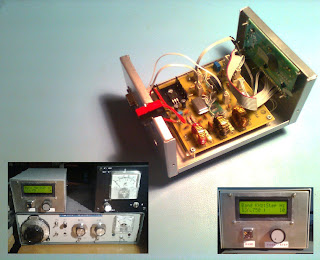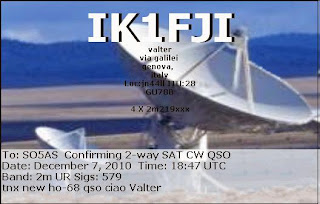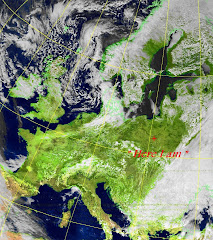-
30 December 2010
DDS deadline met
I have completed the first prototype of the dual-band frequency synthesiser, ( just before my self imposed deadline of the end of the decade ), by writing the last piece of the software to tune the output frequency up and down in 1Hz or 10Hz steps. This function works perfectly; whatever the actual output frequency, it precisely matches the frequency indicated on the display, as of course it should do. So 2010 will end on that happy note. But what about the future ?
This first prototype is what I would consider as a ' concept and technology demonstrator'. For the second prototype synthesiser I have decided to change to a more sophisticated PIC microcontroller, and one that has not been in production all that long, e.g., the Microchip PIC18F4550, which will allow me to implement more features. In fact I have already completed about 25% of this prototype , based on "MyDev2"; see posting on 2nd November.
Concerning software, until now I have been programming in Microchip's assembler language. Using 'C' language is probably a better choice in future. I have absolutely no prior experience of 'C'; but what I do know is that its command syntax is more descriptive than assembler, and the code is not type specific to any one manufacturer's microprocessor families. Some of the extended functionality I want for the second prototype is better suited to 'C' and would be extremely difficult to program in assembler for a novice programmer as myself. The PIC18F4550 can be programmed in both assembler and 'C'.
Back to the present, and the first prototype is shown in the upper picture placed on top of my longwave transmitter with which it will be used to gain some operational experience which may suggest improvements or further development. The middle picture is the post-filter rf output voltage displayed on an oscilloscope, showing a 656mV peak-peak pure sine wave. The lower picture is the output frequency of the synthesiser as I tune it from 137700Hz +/- 50Hz in 10Hz steps.
24 December 2010
Stepping up and stepping down
A few hours ago I took my frequency synthesiser project a significant step nearer to completion. I had a 'eureka' moment; not actually in the bath but instead while waiting to go Christmas shopping with my daughter.
A long time ago I had programmed the PIC microcontroller to show the frequency on the liquid crystal display. The number crunching sequences needed are binary to binary coded decimal ( bcd ) conversion, bcd to ascii, and finally, supression of any leading zeros to prepare the number for display.
For weeks I had been baffled why I couldn't achieve this repetitively in order to step the displayed frequency up or down in response to clockwise or counter-clockwise turning of the rotary encoder; the only difference being to include multiple byte addition and subtraction. This I have now managed to do. It's a great result for me and so good to see on the display. Now I can enjoy Christmas and not be distracted by searching for a solution any more.
This was one of the last two crucial issues to be resolved; the other being to increment / decrement the tuning word by the same step size for sending to the synthesiser chip, which should be straightforward. So I ought to be able to complete the prototype frequency synthesiser this month - famous last words !
A long time ago I had programmed the PIC microcontroller to show the frequency on the liquid crystal display. The number crunching sequences needed are binary to binary coded decimal ( bcd ) conversion, bcd to ascii, and finally, supression of any leading zeros to prepare the number for display.
For weeks I had been baffled why I couldn't achieve this repetitively in order to step the displayed frequency up or down in response to clockwise or counter-clockwise turning of the rotary encoder; the only difference being to include multiple byte addition and subtraction. This I have now managed to do. It's a great result for me and so good to see on the display. Now I can enjoy Christmas and not be distracted by searching for a solution any more.
This was one of the last two crucial issues to be resolved; the other being to increment / decrement the tuning word by the same step size for sending to the synthesiser chip, which should be straightforward. So I ought to be able to complete the prototype frequency synthesiser this month - famous last words !
08 December 2010
XiWANG - Chinese for hope
I had my first radio contact using a satellite as a repeater in 1997, and since then have made a total of 582; an average of less than 45 per year. So I have not been very busy using satellites which have to compete for my time with my many other amateur radio operating interests and construction projects. It usually needs the launch of a new satellite to get me interested again. Such was the case recently when China launched its first amateur radio communications satellite, called XiWang-1, ( Hope-1 ), on 15th December 2009.
Commissioning of this satellite finished in early September 2010, when it was then brought into operational service, using the broadcast callsign BJ1SA-11 and message board callsign BJ1SA-12 with uplink in the 145MHz band and downlink in the 435MHz band. Soon afterwards, I began listening to its beacon transmission in morse code and decoding its data signal, for example,
BJ1SA-11 To DL8DR [21:07:48]
OK DL8DR\\D
BJ1SA-12 To BBSTAT [21:08:05]
Open BJ1SA-12:1
BJ1SA-12 To OZ7SAT [21:08:15]
BJ1SA-11 To PBLIST [21:08:28]
PB: DL8DR\\D
This week I have enjoyed making my first two-way radio contacts through this "bird"; so far with other amateur radio stations in Italy, Norway, France, Belgium and Hungary. I have already received a radio contact confirmation card from one of them.
The antennas I am using are crossed dipoles, ( uplink ), and helical, ( downlink ); both are home-made and can be seen in the picture which I posted on 11th May.
PS. 11th December. After my initial euphoria my enthusiasm has been dampened by the fact that the cw/ssb transponder seems to be turned off for long periods.
Commissioning of this satellite finished in early September 2010, when it was then brought into operational service, using the broadcast callsign BJ1SA-11 and message board callsign BJ1SA-12 with uplink in the 145MHz band and downlink in the 435MHz band. Soon afterwards, I began listening to its beacon transmission in morse code and decoding its data signal, for example,
BJ1SA-11 To DL8DR [21:07:48]
OK DL8DR\\D
BJ1SA-12 To BBSTAT [21:08:05]
Open BJ1SA-12:1
BJ1SA-12 To OZ7SAT [21:08:15]
BJ1SA-11 To PBLIST [21:08:28]
PB: DL8DR\\D
Subscribe to:
Posts (Atom)









